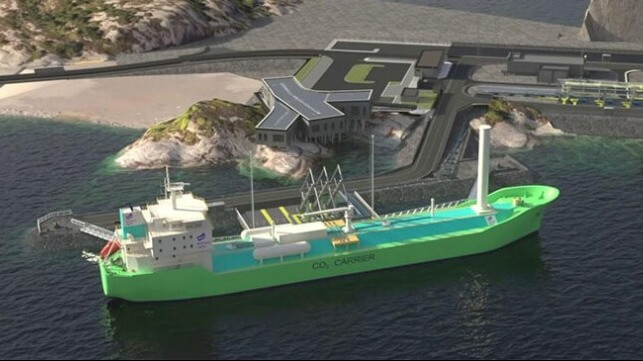Pioneering CO2 Transport Ships Will Use Rotor Sail to Reduce Emissions

Northern Lights, a Norwegian start-up for the transport and storage of CO2, is incorporating auxiliary wind propulsion into the new CO2 transport vessels it has on order in China. A joint venture between Equinor, Shell, and TotalEnergies, Northern Lights is responsible for the transport and storage components of the Longship Project supported by the Norwegian government to decarbonize emissions, including from the industrial area around the country’s capital of Oslo.
Norsepower reports that it has received an order for two of its rotor sail with one to be installed on each of the two vessels being built for Northern Lights by Dalian Shipbuilding Industry Co. in China. Founded a decade ago, Norsepower has modern adaptations of the rotor concept first developed in the 1920s. The company’s solutions, which have been installed on vessels ranging from a Maersk tanker to a passenger ship, bulker, and ro-ro, harness wind power and generate thrust that reduces both fuel consumption and emissions.
The two liquified CO2 carriers, which Northern Lights ordered from Dalian in October 2021, will each be fitted with a rotor measuring 28 x 4 meters (approximately 92 x 13 feet). The rotor sails will be delivered in early 2023 to Dalian. The vessels are due for completion and delivery by mid-2024.
Each of the vessels will measure 426 feet in length with a carrying capacity of 7,500 cbm of CO2. Norsepower estimates based on its calculations that the rotor sails will reduce the fuel and CO2 emissions from each vessel by approximately 5 percent.
“The industry is transforming quickly and newbuild vessels are being built today to operate efficiently ahead of 2050,” said Tuomas Riski, CEO of Norsepower. “We are seeing the industry seeking to build vessels today which already have proven energy efficiency solutions onboard which can reduce fuel consumption, the associated costs as well as reduce emissions. This initiative highlights the role that cleaner shipping has within complex supply chains and decarbonization strategies outside of the immediate industry.”
Northern Light said when it ordered the vessels that hoped these first-of-their-kind vessels would potentially set a new standard for CO2 shipping on coastal trading routes. In addition to the wind rotor, the design incorporates other innovative technologies including air lubrication along the hull. Northern Lights expects that these technologies will reduce the vessel’s carbon intensity by around 34 percent compared to conventional ships. The ships will be registered in Norway and classed by DNV.
Once in operation, the ships will load captured and liquefied CO2 from European emitters and transport it to the Northern Lights receiving terminal in Øygarden in western Norway. Northern Lights' goal is to enable the first European full-scale carbon capture and storage value chain, paving the way for cost reductions and scale-up of similar, future projects.
